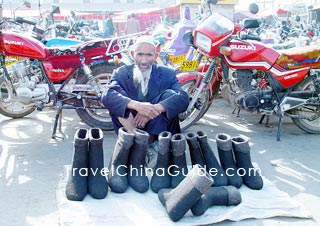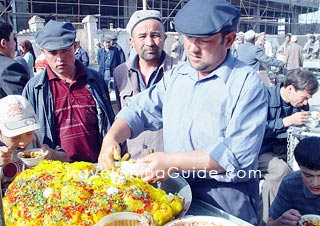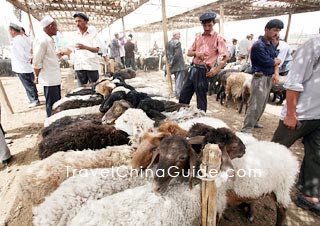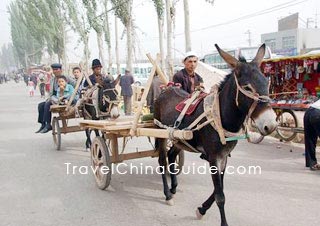Bazaar is Uygur language, meaning market and trade place. The traditional bazaar was originally held on Sundays, but it currently is divided into two sections, one is livestock district that is only open on Sundays and the other is ordinary district especially busy on Sundays although open every day.
 | | Kashgar Bazaar | |  | | Local snack sold in the bazaar | |
At present, there are more than 20 large scale bazaars in Kashgar, of which the one located at the East Gate of Kashgar City is the largest. This bazaar also named 'International Trade Market of Central and Western Asia' is the largest international trade market in Northwest China, enjoying the fame 'Material Fair of Central Asia'. It is the largest garden aggregate market of Kashgar City and in Xinjiang Province, taking up an area of 250 mu (41 acres), composed of 21 specialized markets including over 4,000 fixed booths and a food street. It was noted as 'the Largest Fair in Asia' in ancient times. As early as in 128 BC, when Zhang Qian was dispatched to the Western Regions by Emperor Wudi of the Han Dynasty (206 BC-220), he was surprised to see the prosperous market here, full of dazzling goods and merchants coming from different countries.
At the fair, you can enjoy and buy various things such as general merchandise, handicrafts, livestock, local specialties, vegetables, coat, and second hand items as well as many other kinds of things from cattle and horses to needle and thread. Since Khunjerab Pass and Tuergate Port were opened, a large number of foreign merchants have come with a great deal of goods. Thus, arts and crafts of Pakistan, scarves of Turkey, dry fruits of Saudi Arabia all can be bought at a reasonable price here. Moreover, you can experience an ancient peculiar trade form - barter.
 | | Cattle market | |  | | People go to bazaar by donkey cart | |
Tips:
Bazaar Delicacies: roasted sheep, Xinjiang Kebabs, Zhua Fan (Rice Eaten with Hands), nang (a kind of Uygurs' food), Youtazi (Steamed multilayer bread).
Local specialties: carpets, clay pottery, jewelry, folk musical instruments, guavas, almonds, figs, grapes and melons.
Etiquette: If you don't want to buy the thing you have had a look at because of the price or other reasons, please put your right hand on your heart to say 'I think I'll leave it. Thank you just the same.'
Best time to visit: August and September
- Last updated on Apr. 12, 2021 -



